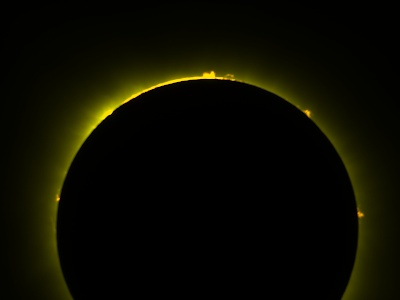This post comes about three months later than it should but, as they say, better late than never. I had an amazing trip to Hamilton, Texas to witness the total solar eclipse. I did my best to both capture the eclipse and to travel light. The photo is me with my Unistellar Odyssey Pro telescope and a DSLR camera at left.
 |
Thankfully, during the first half of the eclipse the weather was mostly cloudless. The telescope had no trouble finding, focusing (it has auto focus) and tracking on the Sun. But as the eclipse progressed and the Sun began to take on more of a crescent appearance the tracking wasn't very good and I had to manually correct the tracking to keep the Sun in view.
My biggest concern was totality. How would the telescope and its software handle seeing the Sun when the Sun didn't look like it normally does? Would the exposures be okay? Color was a big concern too. As I have mentioned before the color that the Unistellar telescopes and app give when imaging the Sun is artificial. The telescope's sensor sees farther into the infrared than our eyes do and that adds extra red to the image making the uncorrected image look sort of lavender in color. The app changes the color pallet to give the Sun a more pleasing yellow color. How would it look during totality?
Yellow. Very yellow.
Thankfully, this yellow color cast was easy to correct in Photoshop and I was able to get images like the two below.
Visually, the eclipse was amazing. Ethereal, even. The large red prominence seen at the bottom of the image above was very easy to see with unaided eyes and the corona was fantastic.
There was no way for the Odyssey telescope to capture much of the Sun's corona as its field-of-view is far too small. That's why I brought my DSLR.
I have now seen two total solar eclipses and I don't really feel that any image can adequately capture the beauty of the corona, but I am happy with this image.
After totality, I was so euphoric that it was difficult to remember to keep taking images of the Sun to complete the time-lapse sequence I was shooting, but then the clouds rolled in and it no longer mattered. Still, I was happy to get the entire first half of the eclipse plus totality and that's all that mattered.
I would rate the experience as a total success. Using a 'smart' telescope allowed me to travel with far less gear than most people who photographed the eclipse and I am happy with my results. The next total tolar eclipse isn't until 2026 and I am sure that by then the technology will be even better.





